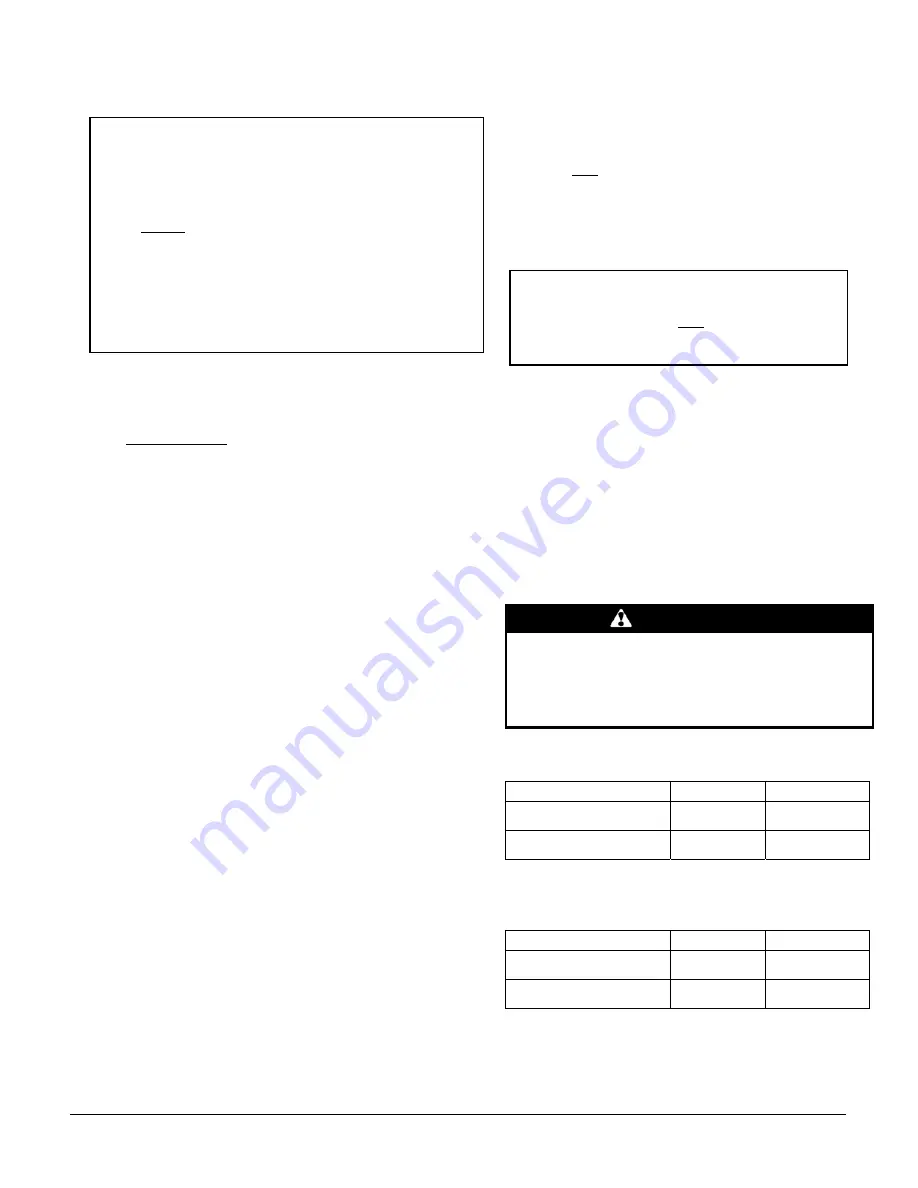
9
CAUTION
Low flue gas temperature increases the risk of
condensation. Adjust the total flue gas temperature
at or higher then 204°C (400°F) in order for the heat
exchanger warranty to remain in force.
3.3.3
C
OMBUSTION
C
HECK
IMPORTANT
The heat exchanger metal surfaces may have oil and the
baffle insulation also contains binders. These products will
burn or evaporate when the unit operates for the first time.
Because of that, the smoke reading may be skewed during the
first minutes of operation. Therefore, the unit must operate
during at least 60 minutes before taking any readings to adjust
the combustion quality. Let the unit cool down before making
any adjustments.
IMPORTANT
The combustion check verification MUST be performed after
the nozzle replacement or the burner cleaning. After these
manipulations, the combustion parameters are necessarily
modified. Refer also to the burner instruction manual.
1.
Pierce a test hole in the flue pipe, approximately 18 inches
from the furnace breech. Insert the smoke test probe into
the hole. For installation using a sidewall venting, use the
orifice provided on the breech plate;
2.
From a cold start, let the unit operate for about 5 minutes;
3.
Set the burner air setting until you have between 0 and 1
on the Bacharach Scale (or a ‘’trace’’);
4.
Take a CO
2
sample at the same test location where the
‘’trace’’ of smoke reading was taken and make note of it.
Example: 13.8% of CO
2
or 2.5% of O
2
;
5.
Adjust the burner air setting to obtain a CO
2
reading 1.5%
lower (or a O
2
reading 2.0% higher) than the reading
associated with the ‘’trace’’ of smoke. Example: 12.3% of
CO
2
or 4.5% of O
2
;
6.
This method of adjusting the burner will result in clean
combustion (Bacharach smoke scale between 0 and a
trace) and ensure the proper functioning of the system.
The optimum CO
2
level is around 12% to 13% (or 3.5% to
5.0% of O
2
).
3.3.4
D
RAFT
R
EGULATOR ADJUSTMENT
On chimney installations only, a barometric draft regulator
(supplied with the furnace) must be installed, in order to ensure
proper draft through the furnace. The barometric damper must
be mounted with the hinge pins in a horizontal position and the
face of the damper vertical for proper functioning (see
instructions included with the damper.) After the furnace has
been firing for at least five minutes, the draft regulator should
be set to between -0.025" and -0.060" W.C.
3.3.5
O
VERFIRE PRESSURE TEST
The overfire draft that is taken through the observation port,
located above the burner, is a measurement necessary to
determine if there is a blockage in the heat exchanger or the
flue pipe. Refer to the Technical Specifications in this manual
for overfire pressure values. A high pressure condition may be
caused by excessive combustion air, due to the air band being
too wide open, or a lack of flue draft (chimney effect) or some
other blockage, such as soot in the secondary section of the
heat exchanger or the use of an oversize nozzle input or high
pressure pump.
3.3.6
V
ENT
T
EMPERATURE
T
EST
1.
After having adjusted the burner combustion, insert a
thermometer into the test hole in the breech pipe;
2.
The total vent temperature should be between 204
and 302°C (400 and 575°F). If not, check for improper
air temperature rise, pump pressure, nozzle size or a
badly sooted heat exchanger. Also refer to section
2.5 for proper flue pipe sizing.
3.3.7
B
LOWER MOTOR TEST
Air adjustment
The units are factory mounted with a variable
diameter pulley on the motor and with a fixed
diameter pulley on the blower. To obtain the air
temperature rise specified in the technical
specification table, the variable pulley must be
adjusted. Refer to Table 3 and 4 for the number of
turns to be applied on the variable pulley.
WARNING
Personal injury or electric shock hazard.
Turn off electric power at fuse box or service panel before
the blower adjustment. Failure to do so can result in bodily
injury and/or death.
Table 1- Blower adjustment
AMT-245 /280
AMT-315 /350
Approximate airflow
(CFM)
3100 3500
Motor pulley adjustment
(Number of turns)
3.5 3
-
With 0.25" W.C. static pressure
Table 2 – Pulley adjustment
AMT-245 /280
AMT-315 /350
Approximate airflow
(CFM)
2780 3400
Motor pulley adjustment
(Number of turns)
2 1
- With 0.50" W.C. static pressure
Summary of Contents for AMT400B34-SM1PMA
Page 16: ...16 Figure 5 Furnace dimensions DNS 0848 Rev E...
Page 17: ...17 Figure 6 Ladder Diagram Heating and Cooling AMT400B34 SM1PMA OLR350H28B...
Page 18: ...18 Figure 7 Wiring Diagram heating and cooling AMT400B34 SM1PMA OLR350H28B DNS 1016 Rev B...
Page 19: ...19 Figure 8 Wiring Diagram Heating AMT400B34 SM1PMA OLR350H289B DNS 1021 Rev B...
Page 20: ...20 COMPONENTS AND REPLACEMENT PARTS...
Page 21: ...21 Figure 9 Parts List With 4 speed motor PSC B50043B...
Page 40: ...18 Figure 6 Diagramme en chelle chauffage et climatisation AMT400B34 SM1PMA OLR350H28B...
Page 42: ...20 Figure 8 Diagramme lectrique chauffage AMT400B34 SM1PMA OLR350H28 DNS 1021 Rev B...
Page 44: ...22 B50043 Rev B Figure 9 Liste de pi ces avec moteur 4 vitesses PSC...









































